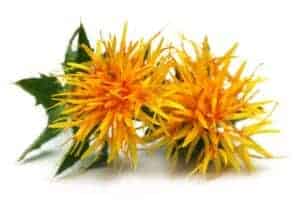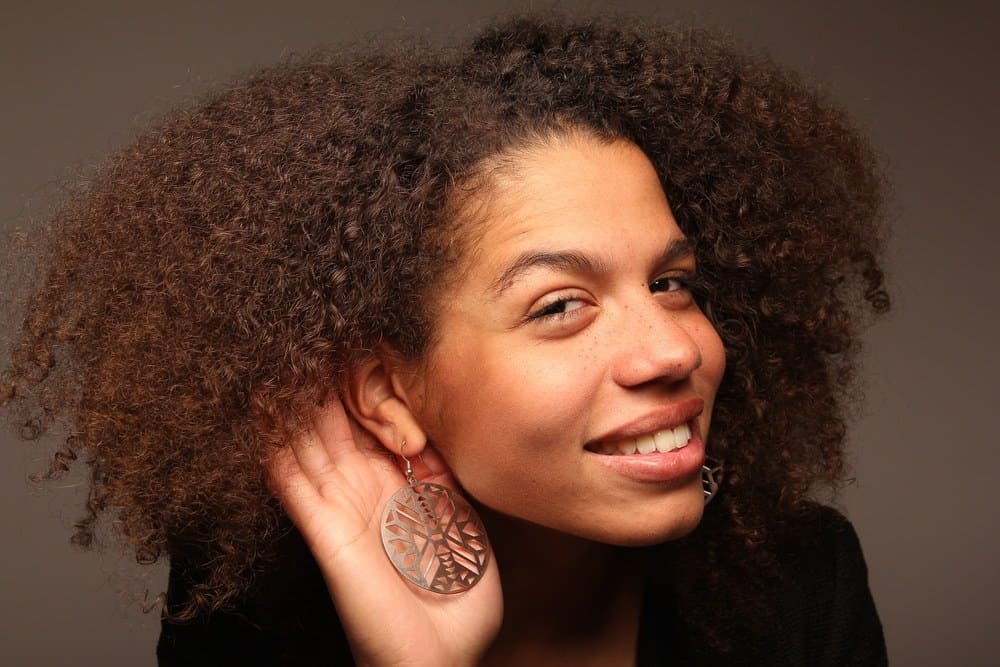
Have you considered using safflower oil for hair growth or to combat hair loss? Does using safflower oil for hair growth really work? Does the oil actually live up to its nickname?
Safflower oil is quite popular among many ladies due to its expected hair care benefits, and some ladies even refer to safflower oil as the "hair growth oil."
Also, few plants can boast a more interesting history than safflower. It has been used in countless ways over the centuries.
The oil's role in your skin and hair care regimen is a lot more complex than it first appears, but its potential rewards are nevertheless enticing.
Table of Contents
What is the Safflower Plant?

The safflower is a thistle-like plant with red, yellow, or orange flowers. It measures up to 60 inches and is used to produce vegetable oil.
Native to rainy environments, the safflower plant contains around 15 to 20 seeds in each branch. One of the oldest crops in the world, the safflower plant, has been used for centuries.
The plant was cultivated during the ancient Egyptian period when dyes were made from the annual safflower plant.
Let's discuss the benefits of using safflower oil for hair growth and for other uses in your hair care regimen.
Safflower Oil 101

The first thing to recognize about safflower oil is that it is not nearly as widespread in its hair care usage as lavender oil, clary sage oil, cedarwood oil, or even sunflower oil.
Instead, if you browse the Internet looking for articles on “safflower oil,” chances are you’ll come across far more articles on how to use it for cooking rather than hair care.
Still, even these articles can yield useful information. For example, a master class on cooking with safflower oil reveals that it’s rich in both Vitamin E and omega-6, both of which are quite relevant to its potential as a scalp-soothing hair-improving product.
The history of safflower is an extensive one – in fact, some think it’s one of the oldest crops in human history, with its usage dating back as far as 4,000 years ago to Ancient Egypt, and garments made from safflower were found within the tomb of Tutankhamen (e.g., "King Tut").
Safflower has likewise been a crucial plant in traditional Chinese medicine for thousands of years, treating menstrual pain and problems along with abdominal and joint pain.
Throughout the ancient world, the plant was also found in Ethiopia, the Persian Empire, the Indian Peninsula, modern-day Sudan and Ethiopia, and Turkey.
Pliny the Elder notes the crop in his Natural History in a section on flowers “known at the time of the Trojan War.”
It was more widely introduced into Europe from Egypt in 1551 as a popular dye, and by the 18th century, it had “blossomed” in popularity in this role in Italy, Britain, and France.
All of this is to say that safflower’s status as a dye or food product is just as long if not longer than its role as a hair care product.
That said, safflower has been used as a hair care product for thousands of years in Chinese, Ayurveda, and Unani culture.
What Are the Benefits of Safflower Oil?

As stated, a lot of the scientific research and applications for safflower oil are centered around culinary use cases rather than the hair care world.
For example, a 2018 study in the Journal of Lipid Research found that safflower oil, among other pure oils tested, was effective at reducing LDC-C, a type of cholesterol often associated with heart disease.
A review of potential medical uses also released in 2018 by Electron Physician revealed positive results for the treatment of many conditions, such as rheumatism, psoriasis, and mouth ulcers.
Closer in relevance for hair care, however, is safflower’s richness in linoleic acid.
If you’re label-savvy and have shopped for skincare products recently, there’s a decent chance you may have seen a mention of linoleic acid, and with good reason.
Linoleic acid helps build the skin’s barrier, keeping moisture in and irritants out, thus making it an effective moisturizer.
For this reason, it has become an increasingly-popular compound to look for in emollients and a mainstay in nail, skin, and hair care products.
Both safflower and sunflower oil is rich in vitamin E, as mentioned above, and that matters because vitamin E is a strong anti-inflammatory.
There is some research to suggest omega-6 can increase inflammation, though other studies assert this threat is overstated and the question is still being actively researched.
Nevertheless, whether or not you need it to mitigate the potential negative side effects of excessive omega-6 intake, vitamin E’s status as a potent anti-inflammatory can help heal your skin, which can be a huge benefit in terms of soothing your scalp.
Safflower oil is safe for most people to take, with oral use being better confirmed in terms of its side effects at present than skin applications.
That said, skin applications are still typically seen as safe.
The best way to test this is to apply a small dose of topical safflower oil to your skin and wait 24 hours – as long as no negative reaction occurs, it should be safe to use on your skin and scalp.

Some cases in which you should not take safflower include:
- Pregnancy or breastfeeding, especially given its previous associations with menstrual pain in traditional Chinese medicine. There is some evidence to suggest that negative interactions, when taken at that time, can exacerbate periods and cause uteruses to contract during this time or even miscarriages.
- Usage for children, as its effects on children (if there are any), have not been widely documented.
- If you suffer from bleeding disorders, safflower oil can slow blood clotting. For this reason, you also shouldn’t take or use safflower for two weeks before surgery.
- If you have an allergy to plants in the Asteraceae/Compositae family (for example, marigolds, daisies, ragweed, chrysanthemums, and so on).
- If you have diabetes, safflower may increase blood sugar.
It is important to underscore, however, the comparative newness of scientific research in this particular aspect of safflower usage.
Many of the claims made about safflower’s efficacy as a skin and hair care product are either part of a recent trend toward essential oils and similar substances within the industry or traditional medicinal practices that are centuries old.
In both cases, while anecdotal evidence is heavily weighted in favor of safflower, official scientific research remains limited, so view claims as to its efficacy in this field accordingly.
What Does Safflower Oil Do for Your Hair?

1. Anti-Inflammatory Properties
One of the most common selling points for essential oils marketed as skin and hair care products is that they can soothe inflammation and keep your skin in good condition.
When it comes to the world of hair care products, this means soothing your scalp.
This is one of the better-substantiated claims of essential oils as hair care products and one of the more solid points in favor of safflower oil as an effective hair care supplement.
Its role as an anti-inflammatory is well-documented, and so it isn’t hard to see how its ability to treat inflammation can extend to scalp care.
There are many cases where anti-inflammatories have been used to promote good hair care.
So it isn’t impossible to see how safflower could be used in that way as well, even if its officially-documented track record is far shorter in that regard.
2. Soothing Scalp Issues

By far the biggest claim for safflower’s use as a modern hair care product is the idea that it can soothe skin and thus ease potential scalp woes.
A big part of that is, as mentioned, its role as an anti-inflammatory.
However, as with much of safflower’s case as a hair care product, its exact abilities are still a subject of debate.
For example, a 2013 study in the Chinese Journal of Integrative Medicine found that safflower had potential anti-inflammatory, anti-oxidant, and pain relief properties.
However, this study was in part anecdotal and not as heavy on quantitative evidence as other studies.
That hasn’t stopped people from using safflower oil as a skin-soothing agent, and claims of its efficacy in this regard and role as an effective moisturizer are widespread enough for many to at least merit consideration.
This is significant because a dry scalp can be a nightmare for your hair, as dry, inflamed skin can cause hair loss.
Safflower’s moisturizing properties may help with everything from dry and inflamed skin to acne and eczema, all of which can cause major hair problems, including hair loss if left unchecked.
3. Oral Supplement

There is an interesting wrinkle with safflower oil being used as a hair and skin care supplement. There is far more data supporting its use in culinary rather than a hair care role.
It may actually be better to take orally rather than the traditional scalp massage oil form used by other essential oils.
That doesn’t mean that it isn’t safe for skin, just that there is less evidence backing up its health claims when used in a skin care capacity.
The flip side of that is that eating foods with safflower oil or otherwise ingesting it in a medically-condoned manner may have positive effects on your skin and hair.
Therefore, safflower oil may be a way of promoting good skin and hair health even at mealtimes.
For example, safflower tea is rich in antioxidants too, so if you’re a tea lover, adding that to your brewing repertoire may be an easy way to add more antioxidants to your system, with all the benefits they can bring.
4. Treating Free Radicals

Safflower is considered to be rich in antioxidants, which makes it a prime candidate for the treatment of free radicals.
Free radicals are unstable molecules that, if left unchecked, can damage patches of hair spreading all over your scalp.
They can be triggered by UV rays and smoke from cigarettes.
They occur as a result of your cellular metabolism and disruptions in your lipid molecules.
When they start to get serious, they can damage the structural layers of your skin, causing tissue damage, as well as its DNA, causing your skin to age prematurely and start to become wrinkled.
Substances rich in vitamin E and antioxidants such as safflower oil can help mitigate the harmful effects of free radicals.
5. Hair Growth

Essential oils are often used to stimulate circulation beneath your skin, thereby helping improve blood circulation to and around your scalp and thus encouraging hair growth.
Safflower can be used as a scalp massage oil to encourage hair growth as well.
This is also an area in which there is a bit more scientific research – a 2011 study in the Journal of Ethnopharmacology wrote of safflower’s efficacy as a hair growth supplement.
If you are looking for another substance with good scalp-hydrating and nourishing properties, safflower oil may be another option to add to your hair care arsenal.
How to Apply Safflower Oil to Your Scalp

Almost unique to safflower oil among its essential oil and alternative hair care product peers is that there aren't very many usage guidelines.
While it has been used in Chinese and Indian hair care traditions for years, unless you’re going to follow one of those centuries-old methods, you’re pretty much left to figure things out on your own.
As a general rule, essential oils are not used in greater quantities than a couple of drops per mixture, since adding more can pose a risk of eliciting skin irritation.
You can either apply these drops on their own, massaging them into your scalp or mix them into a shampoo and apply everything at once.
As mentioned above, the fact safflower has such a strong culinary history also means you have the unique option of trying it out in tea or tablet form, or as part of a meal.
You won’t get the kind of immediate spot-targeted effect as rubbing it directly into your scalp, but you may still be able to reap some of its skin-clearing or general soothing benefits.
Safflower Seed Oil: Other Uses & Scientific Research

Safflower seed oil carries the same nutritional value as sunflower oil although, unlike sunflower oil, it is flavorless and colorless.
It is used in cosmetics and in the food industry to make cooking oil, salad dressing, and margarine.
There are two kinds of safflower seed oils that are produced by two different types of safflower.
The first one, oleic acid, is rich in monounsaturated fatty acid. It is predominantly used in the manufacturing of edible oils or cooking oils.
It actually has lower saturated fat content than olive oil. The second one, linoleic acid, is high in polyunsaturated fatty acids.
It is mainly used to replace linseed oil in paints as its colorless composition makes it a good substitute.
A study was published in 2009, by The American Journal of Clinical Nutrition, that compared the effects of safflower oil that was rich in linoleic acid with pure conjugated linoleic acid on obese women.
The result showed a significant decrease in body fat and increased adiponectin levels in the women who consumed safflower oil.
In another study, high linoleic acid was used to replace animal fats in the diets of patients who suffered from heart disease.
Patients who consumed more safflower oil were more prone to fatal heart and cardiovascular diseases. A meta-analysis of linoleic acid proved that it carried no cardiovascular benefits.

People have been using safflower oil for thousands of years for everything from dyes to dinners to DIY skin and hair care, and they aren’t going to stop any time soon.
That backing helps offset its newness in the realm of scientifically-examined hair care and makes it an intriguing all-natural option for hair growth and scalp renewal that’s at once old and new.




